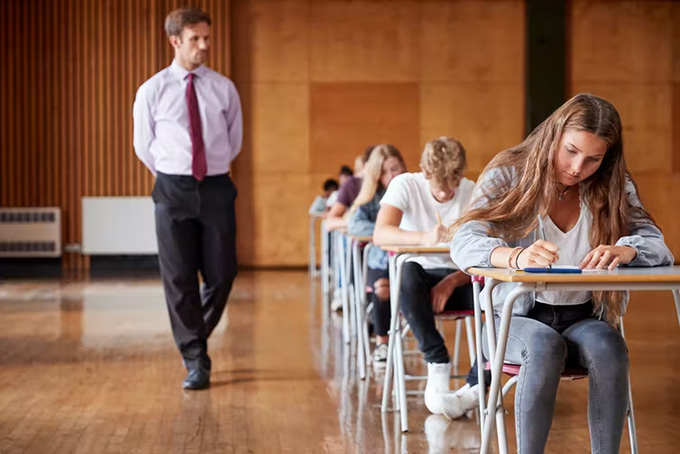 The pandemic pushed universities to launch or accelerate plans for delivering examinations online. These forced transitions have often been painful, involving stress and burnout. Exams have been a big pain point.
There are many accounts from the pandemic of widespread cheating in online exams. These range from the amusing to the depressing. Regardless, cheating creates problems for everyone involved.
We do need to understand students’ achievements to effectively determine, plan and support student learning. Assessment is meant to inform this understanding.
Exams are high-stakes opportunities for generating big “chunks” of evidence of student achievement. Cheating invalidates this evidence, which has a knock-on at individual, course and program levels.
Academic program reviews, for example, are often guided by analyses of that year’s exam results. Exam data help staff make changes to the program. If a significant percentage of exam scores result from cheating, this can lead to misjudgments about the curriculum and missteps in designing future exams.
The pandemic pushed universities to launch or accelerate plans for delivering examinations online. These forced transitions have often been painful, involving stress and burnout. Exams have been a big pain point.
There are many accounts from the pandemic of widespread cheating in online exams. These range from the amusing to the depressing. Regardless, cheating creates problems for everyone involved.
We do need to understand students’ achievements to effectively determine, plan and support student learning. Assessment is meant to inform this understanding.
Exams are high-stakes opportunities for generating big “chunks” of evidence of student achievement. Cheating invalidates this evidence, which has a knock-on at individual, course and program levels.
Academic program reviews, for example, are often guided by analyses of that year’s exam results. Exam data help staff make changes to the program. If a significant percentage of exam scores result from cheating, this can lead to misjudgments about the curriculum and missteps in designing future exams.
Turnitin, online exams, essay mills, being pressured to do a degree in a different language….academic misconduct is bceoming a huge issue https://t.co/wIjD2FSyFN
— Ella Taylor-Smith (@EllaTasm) June 3, 2022
What happened during the pandemic?
It’s understandable, then, why many universities have embraced remote proctoring. This involves the use of artificial intelligence software to identify and monitor students during exams. The value proposition of remote proctoring is that it easily allows us to replicate virtually the security of an in-person, seated, invigilated exam, wherever our students may be. It seemed like a solution custom-made for the pandemic. There is some evidence of remote proctoring working as intended. However, we must also consider emerging concerns. Many students have been hostile to what they see as inappropriate surveillance practices. There are concerns about universities’ uncritical accusations of cheating in “flagged” cases generated by monitoring software. On the faculty side, it’s becoming clear that remote proctoring does not necessarily lead to less work for staff. It may even increase exam-related workload.Working in educational assessment for two decades has taught me that cheating on exams is a serious, complex issue. It defies easy solutions. Remote proctoring will likely continue to have a role to play. It’s essential, however, that we define that role critically and carefully.Covid-19 prevented students from coming on to campus so universities turned to “online proctoring solutions”. In Australia students initially responded with protest but now online proctoring has become the preferred method for testing.
Learn More: https://t.co/Dozwa7R0uS — Meazure Learning (@MeazureLearning) March 2, 2022
So why not go back to the old ways?
With enrolments growing and in-person teaching resuming, it’s tempting to return to familiar exam practices. Bringing back traditional examinations, however, invites back other well-documented, chronic problems. Orchestrating mass, in-person exams presents a huge challenge. Assuring relevance of traditional exams to modern competencies is also problematic. It’s worth asking ourselves: how satisfied were we really with pre-pandemic exam practices?
Traditional in-person inviligated exams are anything but perfect. Shutterstock
Make scholarly decisions
Scholarship informs our disciplines. It must also inform assessment within our disciplines. Scholarship of teaching and learning (SoTL) in higher education is not new. In my experience, SoTL or SoLT has often de-emphasised or failed to include assessment, as the popular forms of the acronym suggest. Increasingly, we need to embrace SoLTA, that is, scholarship that includes and promotes evidence- and research-supported assessment practices. Embracing SoLTA involves becoming deeply familiar with the best research in assessment and examination practices in higher education and disciplinary contexts. This includes informing practice through consulting highly reputable journals like Assessment and Evaluation in Higher Education. As with our disciplines, we should see ourselves not just as consumers of knowledge but creators, too. This presents an opportunity for universities to support teachers in applying scholarship to teaching, including teaching-focused academics.For assessment to count as authentic it must mean something https://t.co/ZWimhfNWr7 “The research evidence to support the pre-eminence given to the traditional exam is thin, while evidence that exams encourage a narrow and formulaic engagement with knowledge is considerable.” pic.twitter.com/PpHYSgYoJn
— Dr Sam Oakley (@rscsam) March 10, 2021